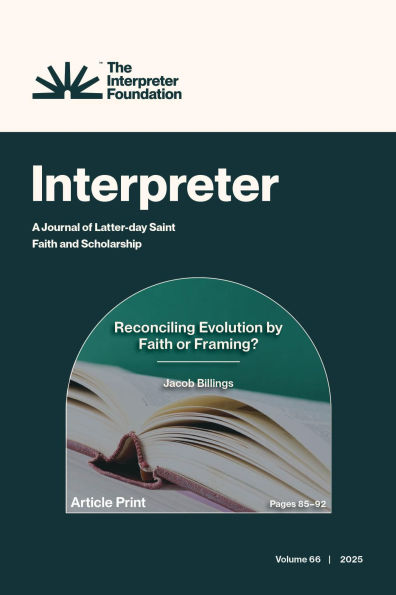Reconciling Evolution by Faith or Framing?
Review of Jamie L. Jensen, Steven L. Peck, Ugo A. Perego, and T. Benjamin Spackman, eds. The Restored Gospel of Jesus Christ and Evolution. Provo, UT: College of Life Sciences, Brigham Young University, 2025. 272 pgs.
Abstract: This review critically evaluates The Restored Gospel of Jesus Christ and Evolution, a multi-author volume that seeks to harmonize evolutionary science with the doctrines and theological framework of The Church of Jesus Christ of Latter-day Saints. While the book offers valuable pedagogical models, personal narratives, and historical context for addressing faith-science tensions, it exhibits notable limitations. Chief among these is an oversimplified distinction between belief and acceptance in scientific discourse, a lack of engagement with legitimate critiques of evolutionary theory, and insufficient resolution of scriptural and theological tensions. Although the collection succeeds in promoting dialogue and reducing conflict among religious students and educators, its rhetorical bias toward scientific consensus and avoidance of unresolved doctrinal issues ultimately weakens its reconciliatory potential. The volume is a meaningful step forward but leaves substantial theological and epistemological work unfinished. The volume's most commendable aspiration lies in its effort to model epistemological reconciliation—not merely tolerance—between scientific and religious modes of knowing, a theme that could benefit from further theological exploration.
1147778823
Abstract: This review critically evaluates The Restored Gospel of Jesus Christ and Evolution, a multi-author volume that seeks to harmonize evolutionary science with the doctrines and theological framework of The Church of Jesus Christ of Latter-day Saints. While the book offers valuable pedagogical models, personal narratives, and historical context for addressing faith-science tensions, it exhibits notable limitations. Chief among these is an oversimplified distinction between belief and acceptance in scientific discourse, a lack of engagement with legitimate critiques of evolutionary theory, and insufficient resolution of scriptural and theological tensions. Although the collection succeeds in promoting dialogue and reducing conflict among religious students and educators, its rhetorical bias toward scientific consensus and avoidance of unresolved doctrinal issues ultimately weakens its reconciliatory potential. The volume is a meaningful step forward but leaves substantial theological and epistemological work unfinished. The volume's most commendable aspiration lies in its effort to model epistemological reconciliation—not merely tolerance—between scientific and religious modes of knowing, a theme that could benefit from further theological exploration.
Reconciling Evolution by Faith or Framing?
Review of Jamie L. Jensen, Steven L. Peck, Ugo A. Perego, and T. Benjamin Spackman, eds. The Restored Gospel of Jesus Christ and Evolution. Provo, UT: College of Life Sciences, Brigham Young University, 2025. 272 pgs.
Abstract: This review critically evaluates The Restored Gospel of Jesus Christ and Evolution, a multi-author volume that seeks to harmonize evolutionary science with the doctrines and theological framework of The Church of Jesus Christ of Latter-day Saints. While the book offers valuable pedagogical models, personal narratives, and historical context for addressing faith-science tensions, it exhibits notable limitations. Chief among these is an oversimplified distinction between belief and acceptance in scientific discourse, a lack of engagement with legitimate critiques of evolutionary theory, and insufficient resolution of scriptural and theological tensions. Although the collection succeeds in promoting dialogue and reducing conflict among religious students and educators, its rhetorical bias toward scientific consensus and avoidance of unresolved doctrinal issues ultimately weakens its reconciliatory potential. The volume is a meaningful step forward but leaves substantial theological and epistemological work unfinished. The volume's most commendable aspiration lies in its effort to model epistemological reconciliation—not merely tolerance—between scientific and religious modes of knowing, a theme that could benefit from further theological exploration.
Abstract: This review critically evaluates The Restored Gospel of Jesus Christ and Evolution, a multi-author volume that seeks to harmonize evolutionary science with the doctrines and theological framework of The Church of Jesus Christ of Latter-day Saints. While the book offers valuable pedagogical models, personal narratives, and historical context for addressing faith-science tensions, it exhibits notable limitations. Chief among these is an oversimplified distinction between belief and acceptance in scientific discourse, a lack of engagement with legitimate critiques of evolutionary theory, and insufficient resolution of scriptural and theological tensions. Although the collection succeeds in promoting dialogue and reducing conflict among religious students and educators, its rhetorical bias toward scientific consensus and avoidance of unresolved doctrinal issues ultimately weakens its reconciliatory potential. The volume is a meaningful step forward but leaves substantial theological and epistemological work unfinished. The volume's most commendable aspiration lies in its effort to model epistemological reconciliation—not merely tolerance—between scientific and religious modes of knowing, a theme that could benefit from further theological exploration.
0.0
In Stock
5
1

Reconciling Evolution by Faith or Framing?

Reconciling Evolution by Faith or Framing?
eBook
FREE
Related collections and offers
0.0
In Stock

Product Details
| BN ID: | 2940184524009 |
|---|---|
| Publisher: | Interpreter Foundation |
| Publication date: | 07/03/2025 |
| Series: | Interpreter: A Journal of Latter-day Saint Faith and Scholarship , #66 |
| Sold by: | Barnes & Noble |
| Format: | eBook |
| File size: | 324 KB |
About the Author
From the B&N Reads Blog
